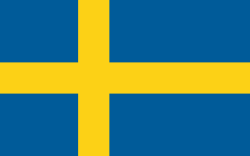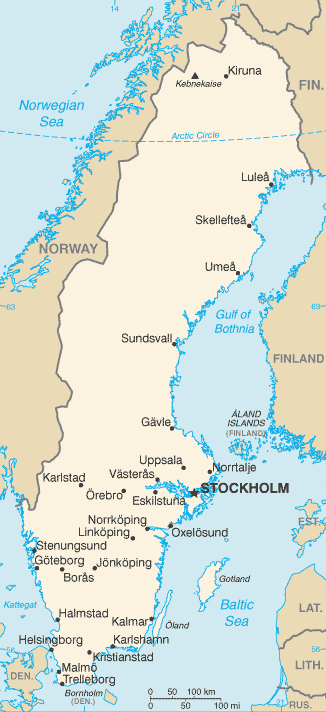Kingdom of Sweden
Related Categories:
 Flag of Sweden
Flag of SwedenBlue with a golden yellow cross extending to the edges of the flag; the vertical part of the cross is shifted to the hoist side in the style of the Dannebrog (Danish flag). |
 Sweden - Fotw
Sweden - FotwThe exact age of the Swedish Flag is not known, but the oldest recorded pictures of a blue cloth with a yellow cross date from the 16th century.
www.fotw.us/flags/se.html Sweden - wikipedia.org
Sweden has a long tradition as a major exporter of iron, copper and timber. Improved transportation and communication allowed more remote natural assets to be utilized on a larger scale, most notably timber and iron ore.
en.wikipedia.org/
Sweden has one of the world's highest life expectancies and one of the lowest birth rates. The country counts at least 17,000 Sami among its population. About one-fifth of Sweden's population are immigrants or have at least one foreign-born parent. The largest immigrant groups are from Finland, Serbia and Montenegro, Bosnia-Herzegovina, Iran, Norway, Denmark, and Poland. This reflects Nordic immigration, earlier periods of labor immigration, and later decades of refugee and family immigration.
Swedish is a Germanic language related to Danish and Norwegian but different in pronunciation and orthography. English is by far the leading foreign language, particularly among students and those under age 50.
Sweden has an extensive child-care system that guarantees a place for all young children from 2-6 years old in a public day-care facility. From ages 7-16, children attend compulsory comprehensive school. After completing the ninth grade, 90% attend upper secondary school for either academic or technical education.
Swedes benefit from an extensive social welfare system, which provides for childcare and maternity and paternity leave, a ceiling on health care costs, old-age pensions, and sick leave among other benefits. Parents are entitled to a total of 12 months' paid leave between birth and the child's eighth birthday, with one of those months reserved specifically for the father. A ceiling on health care costs makes it easier for Swedish workers to take time off for medical reasons.
www.state.gov/r/
Introduction
About
Contact
Symbols in The News
Interpret this Symbol
AAC
African
AI
Alchemy
Alphabets
Ancient
Animal Symbolism
Architecture
Art
Articles
Astrology
Baha'i
Blissymbolics
Blueprint Symbols
Buddhist
Celtic Symbols
Cemetery
Chinese Symbols
Christian
Circle
City
Codes
Color
Conlangs
Crop Circles
Danger
Da Vinci Code
Designing Logos
Dictionaries
Dreams
Education
Egyptian Symbols
Electrical
Emoticons
Find Images
Fonts
Food
Fraternity
Hamsa
Healing
Heraldry
Hermetic
Highway Signs
Hindu
History
Hobo
Holiday
Icons
iConji
Islamic
Jain Symbols
Japanese, Kanji
Jewish
Justice
Law
Literary Symbolism
Mandalas
Map
Masonic
Math, Number
Meaning of Names
Medical
Middle East
Military
Miscellaneous
Money
Music
Mythology
Native American
Playing Cards
Power
Psychology
QiQiiKhu
Reiki
Religious
Runes, Norse
Sacred Geometry
Scientific
Science Fiction
Sorority
Sports
Symbols in the News
Tattoos
ThirteenSymbols
Tree of Life
Ursprache
Videos
Visual Languages
Weather
Web Codes
Wicca
Words
Writing Systems
Braille
Coinherence
Coptic
Cuneiform
Easter Island
Etruscan
Happy Human
Hebrew
Kokopelli
Linear B
Lotus
Love Symbols
Mandorla
Moon Alphabet
Nine Pointed Star
Om
Oz
Phonetic
Scarab Beetle
Silent
Theosophy
Unifon
About
Contact
Symbols in The News
Interpret this Symbol
AAC
African
AI
Alchemy
Alphabets
Ancient
Animal Symbolism
Architecture
Art
Articles
Astrology
Baha'i
Blissymbolics
Blueprint Symbols
Buddhist
Celtic Symbols
Cemetery
Chinese Symbols
Christian
Circle
City
Codes
Color
Conlangs
Crop Circles
Danger
Da Vinci Code
Designing Logos
Dictionaries
Dreams
Education
Egyptian Symbols
Electrical
Emoticons
Find Images
Fonts
Food
Fraternity
Hamsa
Healing
Heraldry
Hermetic
Highway Signs
Hindu
History
Hobo
Holiday
Icons
iConji
Islamic
Jain Symbols
Japanese, Kanji
Jewish
Justice
Law
Literary Symbolism
Mandalas
Map
Masonic
Math, Number
Meaning of Names
Medical
Middle East
Military
Miscellaneous
Money
Music
Mythology
Native American
Playing Cards
Power
Psychology
QiQiiKhu
Reiki
Religious
Runes, Norse
Sacred Geometry
Scientific
Science Fiction
Sorority
Sports
Symbols in the News
Tattoos
ThirteenSymbols
Tree of Life
Ursprache
Videos
Visual Languages
Weather
Web Codes
Wicca
Words
Writing Systems
Braille
Coinherence
Coptic
Cuneiform
Easter Island
Etruscan
Happy Human
Hebrew
Kokopelli
Linear B
Lotus
Love Symbols
Mandorla
Moon Alphabet
Nine Pointed Star
Om
Oz
Phonetic
Scarab Beetle
Silent
Theosophy
Unifon
